How nature shapes better cities?
The benefits of nature in urban environments and its positive impacts on our wellbeing are shaping better cities; a method commonly known as “Biophilia”. Nature has calming effects, it makes us live in harmony, improves our memory, reduces depression, and bonds people together.
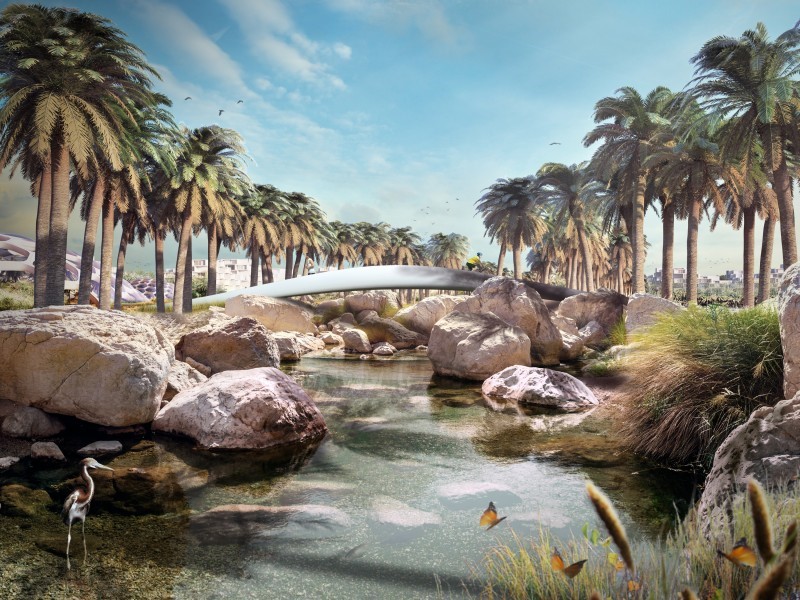
Nexgen sustainable city, landscape design | copyright URB
Biophilia is a rewarding act of enrichment. It is a process of enhancing the quality of our built environments with nature to improve our quality of life. A rapidly growing urban population will have severe impacts on the amount of green space available per capita. This means that there will be less green space per person in in the future. Thus integrating nature into our buildings has become a necessity, as studies are also showing that less people are interacting with nature. In US for example, there has been a 25% decline in nature-based recreation in the last 20 years [1].
Research has shown that living in cities can be toxic for our mental health.
A group of Dutch researchers found that living in a city roughly doubles the risk of schizophrenia [2]. This is a serious problem as it is expected that approximately 70% of people will be living in cities by 2050 [3]. Thus bringing nature into our cities should be an important design priority for improving our wellbeing.
Studies have also shown that death by pollution is on a rapid rise and is the largest environmental cause of disease and death in the world today [4]. Pollution has been increasing due to unsustainable human activities. Rapid population rise and urbanisation are further fuelling climate change.
A solution to these problems is Biophilia; a nature-based methodology providing many benefits for our cities and their inhabitants.
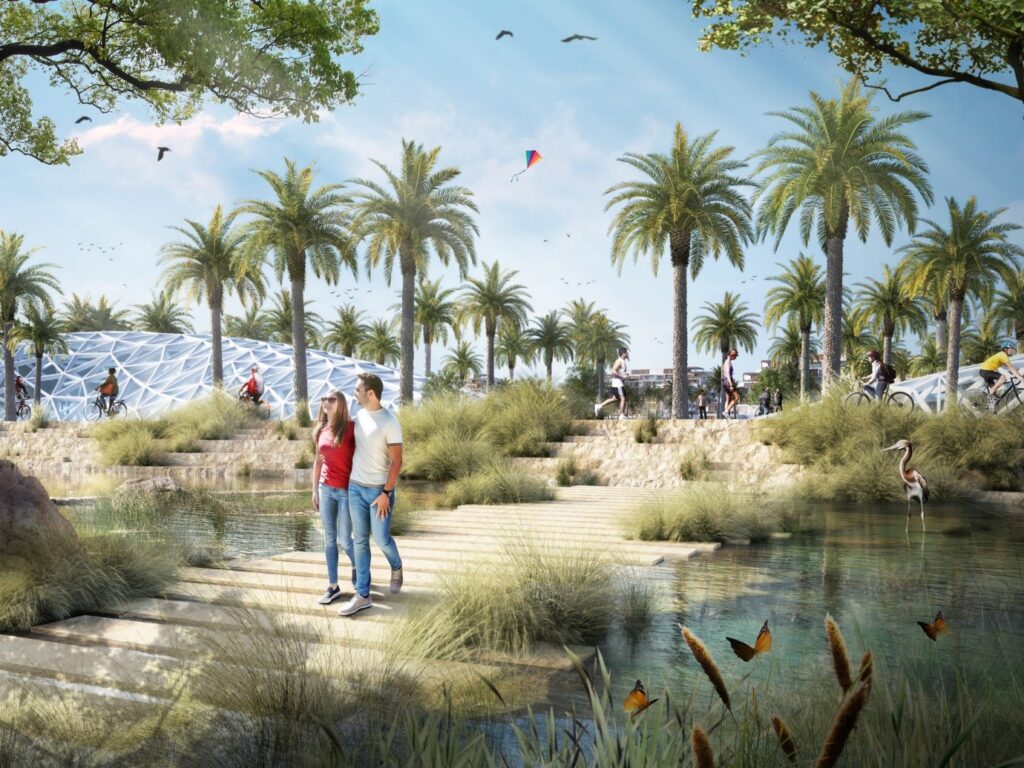
AlNama smart city, landscape design | copyright URB
What is Biophilia?
“Biophilia” was a term pioneered by Erich Fromm in his book The anatomy of human destructiveness published in 1973. Its application was later used and developed by Edward O. Wilson, an American biologist who authored the book Biophilia which was published in 1984. He believed that our connection with nature was integral to our human evolution.
Since then, many designers and architects have used the term “Biophilia” to describe projects integrated with nature. Some of the various terms include Biophilic, Biophilic design, Biophilic buildings, and Biophilic cities.
Biophilic architecture is another; it is a method of creating strong connections between nature and our built environments.
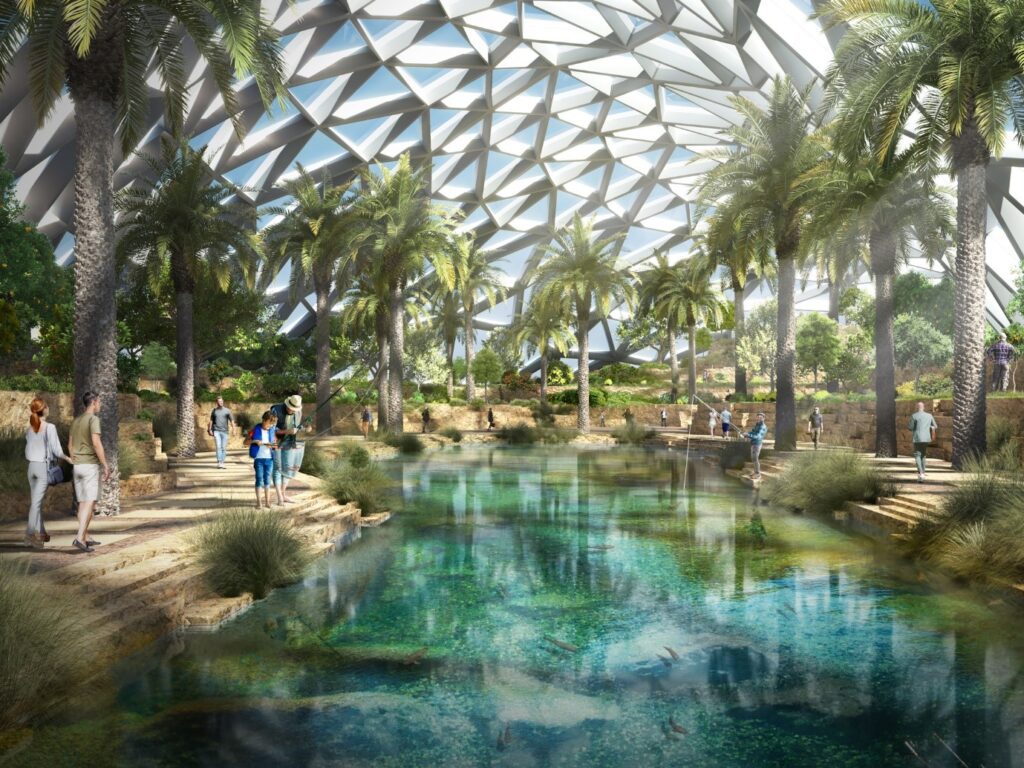
AlNama smart city, biodome design | copyright URB
The methods and applications of Biophilia can vary widely and it can be applied to so many project types.
One of the main reasons that Biophilia is becoming a trend is because of the various benefits it provides. Nature is like a medicine for our mental and physical health. Nature can improve our mood and attention as well as reduce our stress. Nature also provides various environmental and social benefits for our cities, such as reducing air pollution, promoting biodiversity, managing storm water, increasing social interaction and connecting communities together.
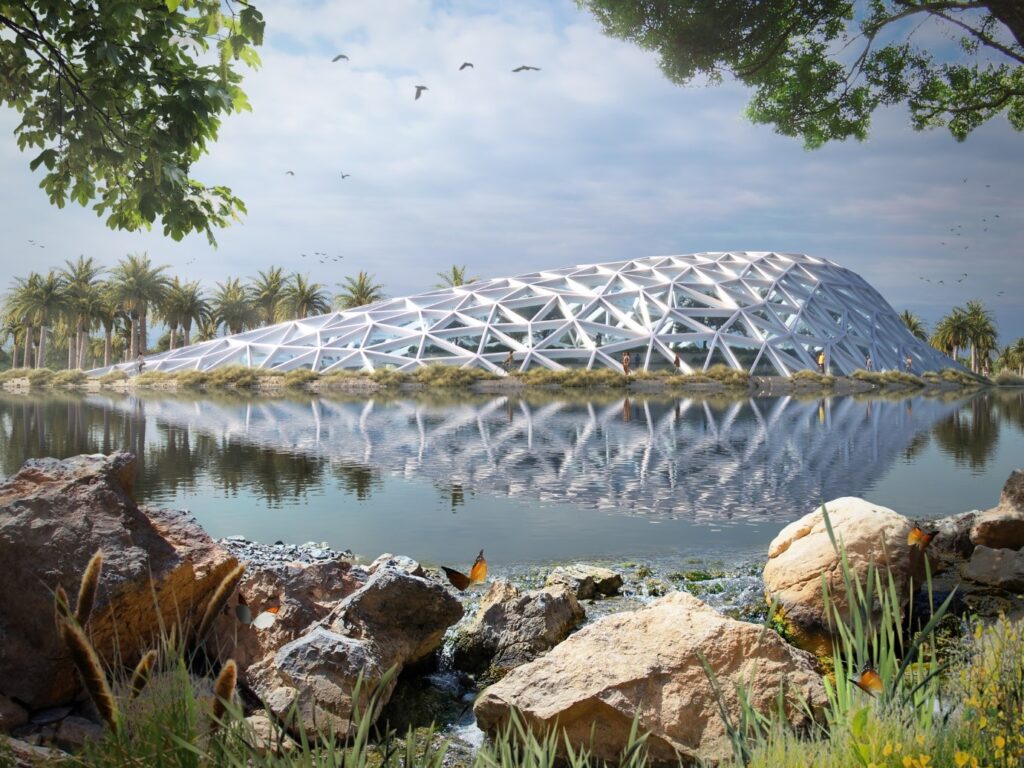
AlNama smart city, landscape design | copyright URB
Thus designing with nature can help shape better cities. This requires a significant shift in the planning of cities; since for the most part of the last century our cities have been designed in such ways that alienate us from nature, devoiding us from the many benefits nature provides. Thus Biophilia can be a healthy refreshing change that our cities so desperately need.
The public and private sector in the built environment must all understand the value of nature, and how developments can be shaped to provide healthy environments using innovative Biophilic techniques.
Biophilia as Green Infrastructure
Green Infrastructure mimics nature to perform multiple functions, thus providing multiple benefits. This multi-functionality is shaping better cities by mitigating the effects of climate change, whilst also creating healthy places for people to live, work and visit.
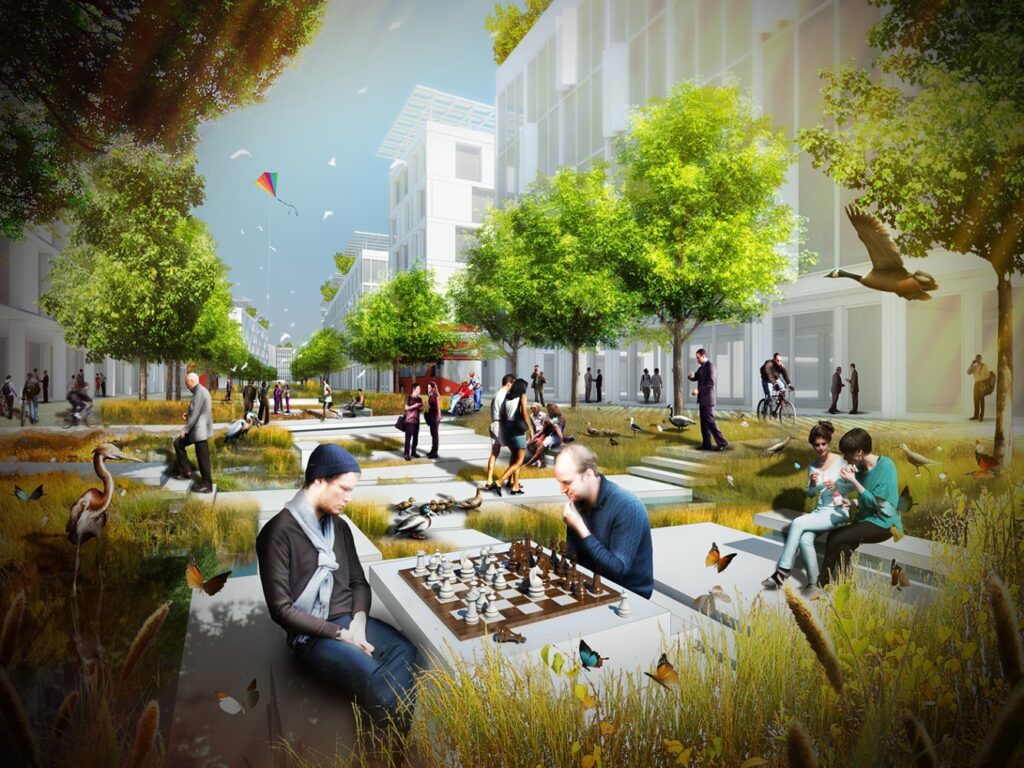
Water Boulevards | copyright URB
There are many types of Green Infrastructure which vary in scale. For example at a city scale, it can be a large collection of natural areas that provide variation of habitats for wildlife, whilst also providing flood protection, better air quality and cleaner water. At a neighbourhood scale, it can be rain water harvesting, food and renewable energy production. Green Infrastructure can also be individual components such as bio-swales, planter boxes, rain gardens, down-sprout gardens, permeable pavements, green streets, green roofs and green parking.
The idea of thinking of Biophilia as Green Infrastructure is to provide solutions that work as a complete network. It is these types of Biophilic projects that are shaping better cities.
Final thoughts
As our urban population is expected to grow rapidly for the remainder of this century, Biophilia can help shape better cities through the use of natural systems. Biophilia’s wide range of applications is allowing a healthy evolution in the built environment. Given that buildings account for 39% of CO2 emissions, it is clear that Biophilia in our cities are essential for a healthy planet. Besides reducing emissions, bringing nature to our urban environments will also reduce pollution which is responsible for an estimated 9 million premature deaths [4].
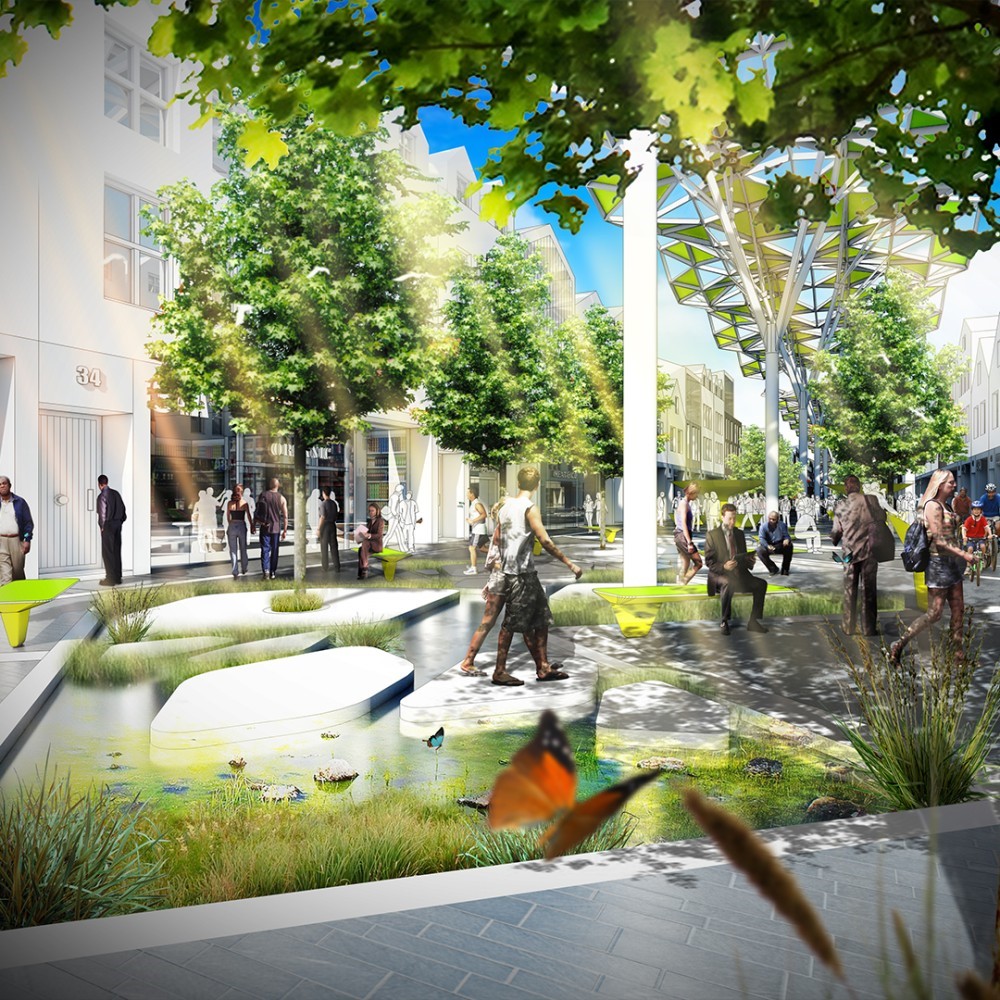
Urban Forest | copyright URB
The unique selling point of Biophilia is in its long-term benefits; as it can provide a variation of social, economic and environmental benefits. Thus ultimately, the real value of Biophilia is its multi-functionality. It is about building with nature to mitigate urban and climatic challenges, whilst also creating healthy places for people to live, work and visit.
References:
- Pergams, Oliver R. W., and Patricia A. Zaradic (2007). Evidence for a Fundamental and Pervasive Shift Away from Nature-based Recreation. National Acad Sciences.
- Krabbendam, L. & van Os, J. Schizophrenia and urbanicity: a major environmental influence–conditional on genetic risk. Schizophr. Bull. 31, 795–799 (2005)
- United Nations, Department of Economic and Social Affairs, Population Division (2014). World Urbanization Prospects: The 2014 Revision, Highlights. United Nations.
- Landrigan, Philip J et al. (2017). The Lancet Commission on pollution and health. The Lancet.
About the author
Baharash Bagherian is the CEO of URB and has masterminded designs of various sustainable cities currently under construction. As a visionary changemaker, Baharash Bagherian founded URB with a sense of purpose to accelerate the world’s transition towards sustainable developments. He leads URB to develop the highest standards of sustainable destinations, through his unique expertise as well as sustainability know-how. He also heads the world’s first urban tech incubator for sustainable cities, which aims to foster a collaborative ecosystem of innovators, whilst investing in start-ups that are solving critical challenges related to urbanization & climate change.
Baharash Bagherian is also the author of ‘Human Centric Urban Innovations’. His book provides unique blueprints of the next generation of sustainable cities, as well as the types of assets and infrastructures required to create such human centric cities. His book will inspire anyone interested in urban planning to rethink our approach to designing new cities, whilst also regenerating our existing built environments.
